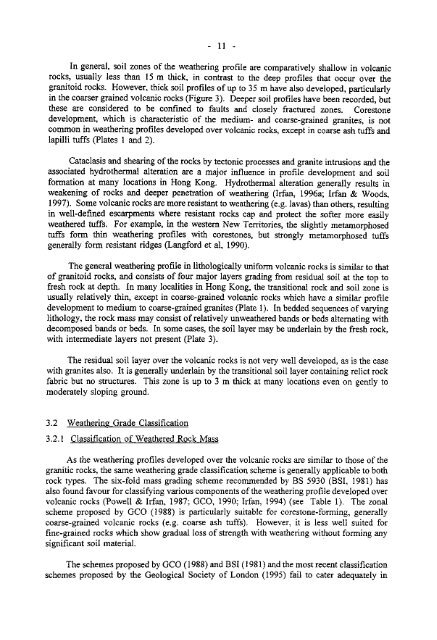mineralogical and fabric characterization and classification of ...
mineralogical and fabric characterization and classification of ...
mineralogical and fabric characterization and classification of ...
You also want an ePaper? Increase the reach of your titles
YUMPU automatically turns print PDFs into web optimized ePapers that Google loves.
- 11 -In general, soil zones <strong>of</strong> the weathering pr<strong>of</strong>ile are comparatively shallow in volcanicrocks, usually less than 15 m thick, in contrast to the deep pr<strong>of</strong>iles that occur over thegranitoid rocks. However, thick soil pr<strong>of</strong>iles <strong>of</strong> up to 35 m have also developed, particularlyin the coarser grained volcanic rocks (Figure 3). Deeper soil pr<strong>of</strong>iles have been recorded, butthese are considered to be confined to faults <strong>and</strong> closely fractured zones. Corestonedevelopment, which is characteristic <strong>of</strong> the medium- <strong>and</strong> coarse-grained granites, is notcommon in weathering pr<strong>of</strong>iles developed over volcanic rocks, except in coarse ash tuffs <strong>and</strong>lapilli tuffs (Plates 1 <strong>and</strong> 2).Cataclasis <strong>and</strong> shearing <strong>of</strong> the rocks by tectonic processes <strong>and</strong> granite intrusions <strong>and</strong> theassociated hydrothermal alteration are a major influence in pr<strong>of</strong>ile development <strong>and</strong> soilformation at many locations in Hong Kong. Hydrothermal alteration generally results inweakening <strong>of</strong> rocks <strong>and</strong> deeper penetration <strong>of</strong> weathering (Irfan, 1996a; Irfan & Woods,1997). Some volcanic rocks are more resistant to weathering (e.g. lavas) than others, resultingin well-defined escarpments where resistant rocks cap <strong>and</strong> protect the s<strong>of</strong>ter more easilyweathered tuffs. For example, in the western New Territories, the slightly metamorphosedtuffs form thin weathering pr<strong>of</strong>iles with corestones, but strongly metamorphosed tuffsgenerally form resistant ridges (Langford et al, 1990).The general weathering pr<strong>of</strong>ile in lithologically uniform volcanic rocks is similar to that<strong>of</strong> granitoid rocks, <strong>and</strong> consists <strong>of</strong> four major layers grading from residual soil at the top t<strong>of</strong>resh rock at depth. In many localities in Hong Kong, the transitional rock <strong>and</strong> soil zone isusually relatively thin, except in coarse-grained volcanic rocks which have a similar pr<strong>of</strong>iledevelopment to medium to coarse-grained granites (Plate 1). In bedded sequences <strong>of</strong> varyinglithology, the rock mass may consist <strong>of</strong> relatively unweathered b<strong>and</strong>s or beds alternating withdecomposed b<strong>and</strong>s or beds. In some cases, the soil layer may be underlain by the fresh rock,with intermediate layers not present (Plate 3).The residual soil layer over the volcanic rocks is not very well developed, as is the casewith granites also. It is generally underlain by the transitional soil layer containing relict rock<strong>fabric</strong> but no structures. This zone is up to 3 m thick at many locations even on gently tomoderately sloping ground.3.2 Weathering Grade Classification3.2.1 Classification <strong>of</strong> Weathered Rock MassAs the weathering pr<strong>of</strong>iles developed over the volcanic rocks are similar to those <strong>of</strong> thegranitic rocks, the same weathering grade <strong>classification</strong> scheme is generally applicable to bothrock types. The six-fold mass grading scheme recommended by BS 5930 (BSI, 1981) hasalso found favour for classifying various components <strong>of</strong> the weathering pr<strong>of</strong>ile developed overvolcanic rocks (Powell & Irfan, 1987; GCO, 1990; Irfan, 1994) (see Table 1). The zonalscheme proposed by GCO (1988) is particularly suitable for corestone-forming, generallycoarse-grained volcanic rocks (e.g. coarse ash tuffs). However, it is less well suited forfine-grained rocks which show gradual loss <strong>of</strong> strength with weathering without forming anysignificant soil material.The schemes proposed by GCO (1988) <strong>and</strong> BSI (1981) <strong>and</strong> the most recent <strong>classification</strong>schemes proposed by the Geological Society <strong>of</strong> London (1995) fail to cater adequately in
















